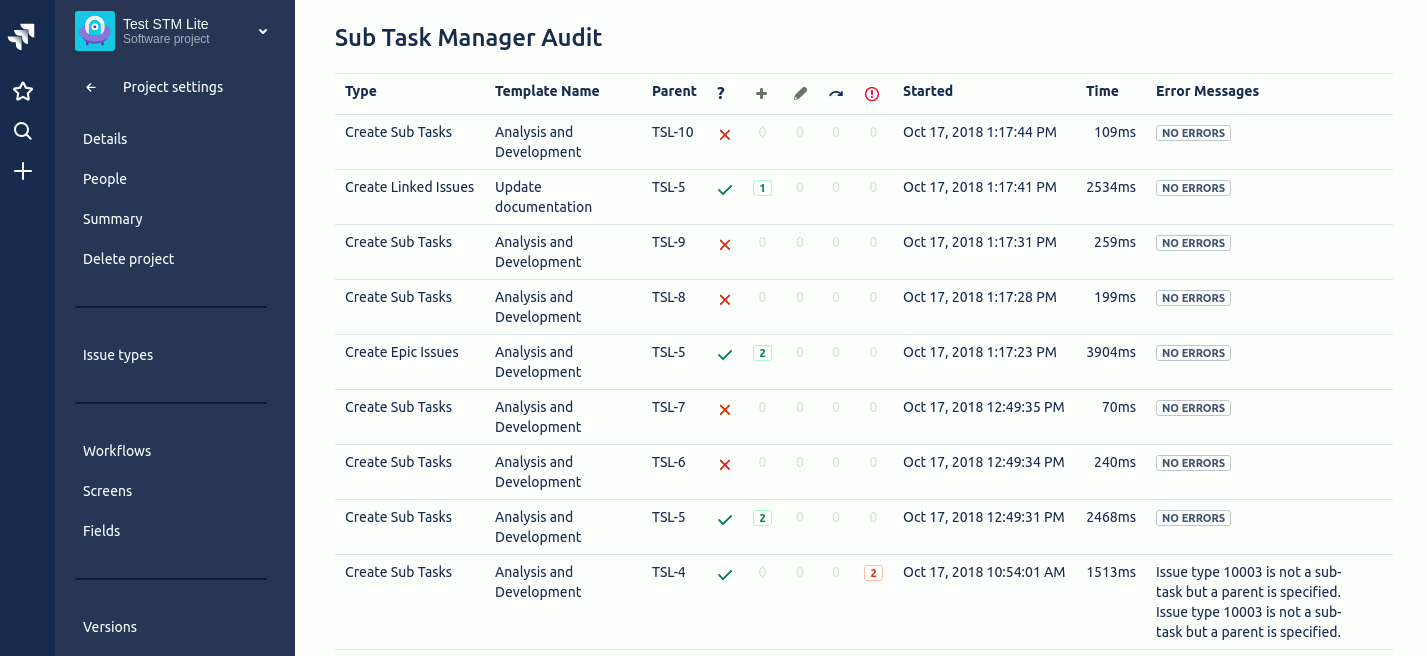Sub Task Manager Lite for Jira Cloud
NOTE: This is the Lite version of Sub Task Manager. If this plugin doesn't have all the features you need then please see Sub Task Manager for greater functionality and configuration.
Sub Tasks, Linked issue, and Epic Issues are a common method for breaking up the work involved in a JIRA Issue. Sub Task Manager Lite makes the creation of these Sub Tasks, Linked Issues or Epic Issues a lot easier.
Templates can either be created for a specific project. These can then be used in to create multiple Sub Tasks / Linked Issues / Epic Issues manually by selecting a pre-defined template (you can optionally changing a few values if you wish).
You can also create templates automatically using Executors. This allows you to specify if they are created on Issue creation or a transition. This can create Sub Tasks, Linked Issues or Epic Issues with optional criteria (for issue type or the current user)
Important: The fields that are displayed and the fields that can be copied from the parent are dependent on having been set up for the Create Issue screen in the project (Project Administration -> Screens -> Create Issue). If, for example, the due date is not in the Create Issues screen then it will not appear as an entry field, as a show field checkbox or as a copy from parent checkbox.
Warning: Creating issues automatically is incredibly powerful. You need to be careful that you don't set up loops (Issue A creates linked Issue B which creates linked Issue C ....).
Sections:
-
Defining Template for Sub Tasks / Linked Issues / Epic Issues
-
Manually Creating Bulk Sub Tasks / Linked Issues / Epic Issues
Defining Templates for Sub Tasks/Linked Issues/Epic Issues
For this section whenever Sub Tasks is mentioned the same will also apply for Epic or Linked Issues.
Templates for Sub Tasks are defined for each Project. The Sub Task Templates screen is available as a Project tab (go to the project -> Add-ons -> STM Lite Templates) and can be accessed by Project Admins only. The image below shows the screen where templates can be added and edited
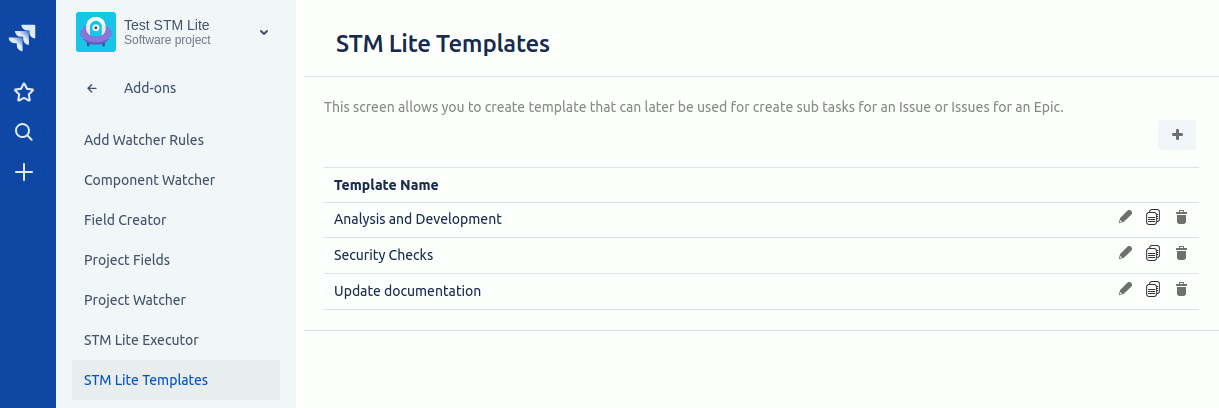
Once a template has been defined it can be edited (pencil icon), duplicated (copy icon) or deleted (trash can icon).
New templates can be added by clicking on the add button (plus icon, top right hand corner) and this will open the dialog below.
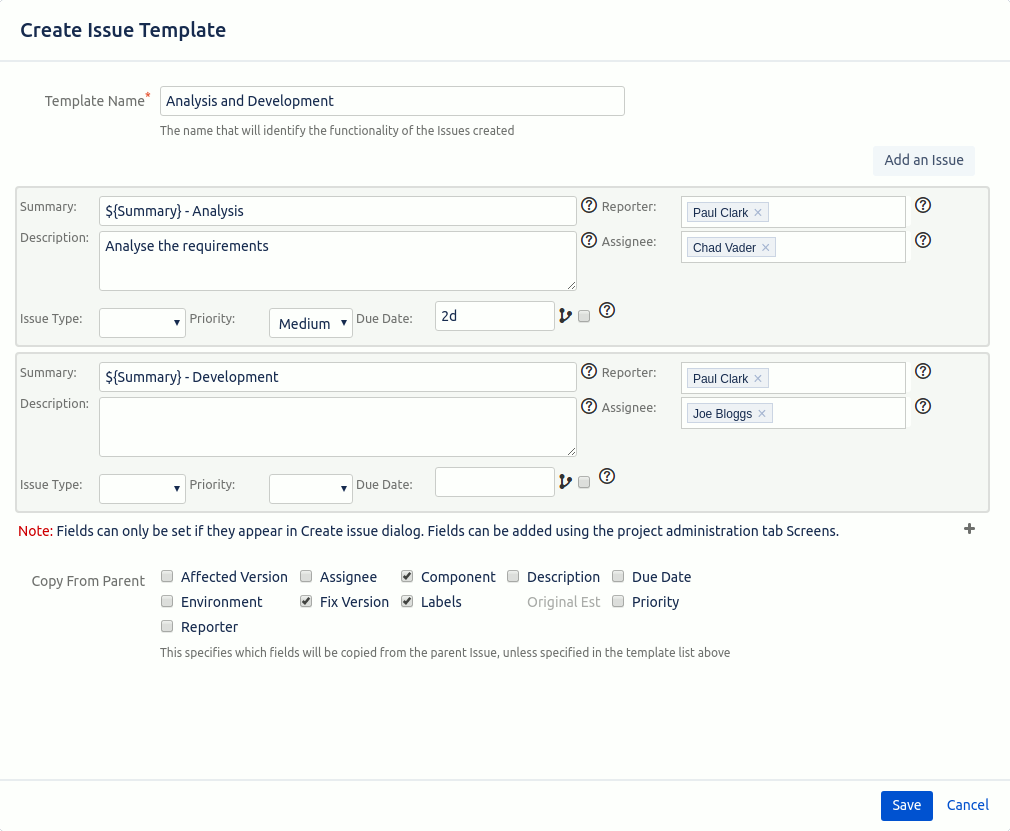
Each template has a name that will help identify the template, a list of issues that should be created and a list of fields to copy from the parent.
Issue List
The Issue list is a list of all Issues that would be created for this template. The example above will create two issues but you are free to define any number you like as long as you have at least one. Occurrences of question marks in a circle are help for the field to the left of the question mark. Hovering over this will give you helpful information about the field.
The following fields are available in the Sub Task list (NOTE: if a field doesn't appear then you may need to go to the Project Admin screen -> Screens and add that field to the create screens)
-
Summary: the summary of the Issue. You can refer to parent fields here by using one of: ${Summary}, ${Description}, ${Type}, ${Assignee}, ${Reporter}, ${Priority} or to a custom field, i.e. ${My Custom Field Name}. If no value is present then the word null show unless an ! is placed after the $ symbol (i.e. $!{Description} will show the description if it is present otherwise it will show nothing). Field references are case sensitive.
-
Assignee: The user that the issue will be assigned to. You can also refer to the parent issues reporter or assignee by entering ${Reporter} or ${Assignee} respectively.
-
Description: a description of the Issue. You can also refer to the same fields as defined for the Summary (i.e. ${Reporter})
-
Due Date: either the word today (for day the Sub Task is created), a date (in the format YYYY-MM-DD) or the number of days, weeks and months from the day the Sub Task is created (i.e. 1m 2w 3d for one month, two weeks and three days, 2d for two days ...)
-
Issue Type: Defined the issue type for this issue
-
Priority: one of the pre-defined priorities for an Issue
- Reporter: Start typing the user's name and a selection of matching names will appear. You can also refer to the parent issues reporter or assignee by entering ${Reporter} or ${Assignee} respectively.
When you initially create a template one issue is automatically added and all fields (that are in the create screen). The fields that are showing don't necessarily have to have values in them. This allows the user, using the template to manually create Sub Tasks, to easily enter the reporter with minimum fuss.
Copy From Parent
These checkboxes signify that the values (for the fields they represent) should be copied from the parent Issue to the Sub Task issues. For the example above just the Description fields will be copied from the parent Issue to all of the Sub Tasks. The only time these fields will NOT be copied is if the field's value is set for the issue in the Issue list.
NOTE: The fields that are displayed and the fields that can be copied from the parent are dependant on having been set up for the Create Issue screen in the project (Project Administration -> Screens -> Create Issue). If, for example, the due date is not in the Create Issues screen then it will not appear as an entry field, as a show field checkbox or as a copy from parent checkbox.
Manually Creating Bulk Sub Tasks/Linked Issues/Epic Issues
To manually create bulk Sub Tasks, create Linked Issues or create Epic Issues go to the Issue that will be the parent, click the More dropdown button and select either Create Bulk Linked Issues, Create Bulk Epic Issues or Create Bulk Sub Tasks. Epic Issue creation is only available if you are running the "JIRA-Software" version of JIRA.

The following dialog will be displayed. The difference between the Sub Task and Epic Issue dialogs is the title and the Issue Types that can be selected.
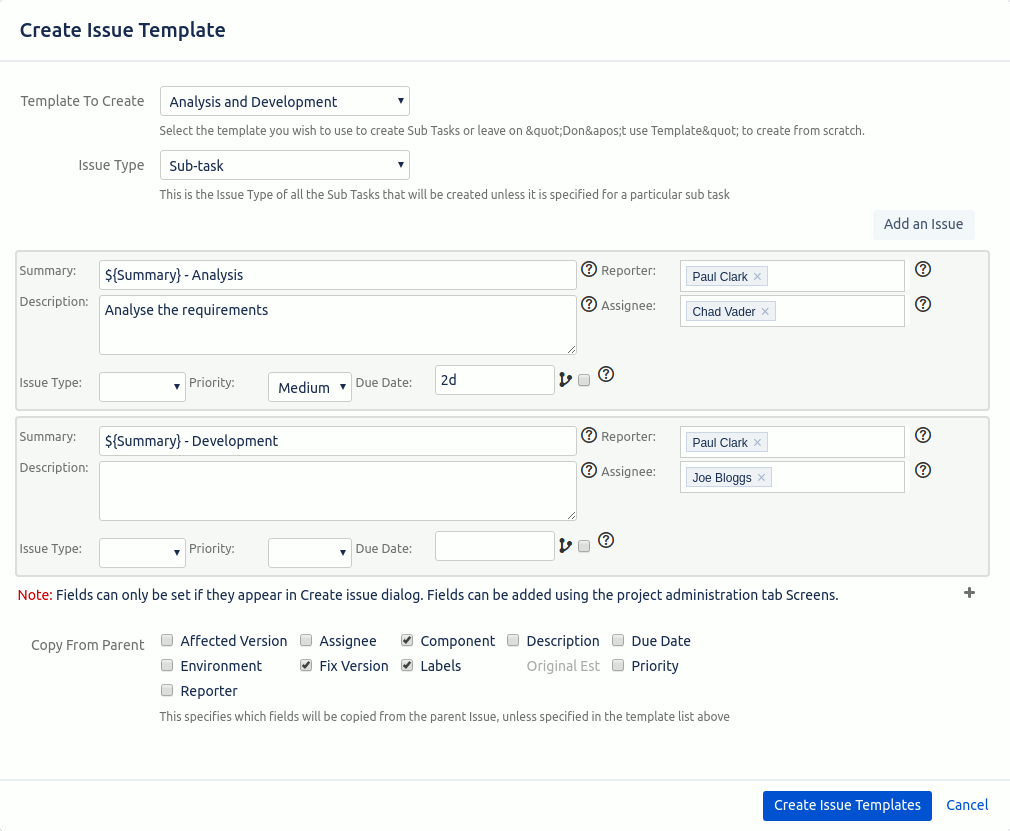
This dialog is very similar to the one for creating templates in the STM Lite Template screen. The main difference is instead of a template at the top you select list of all templates for this Project and an Issue Type select to specify the Issue Type of the new Sub Tasks / Epic Issue.
There are two ways of using this dialog: creating Issues from a template or creating Issues from scratch.
Create bulk Issues from a template
To create bulk Issues from a template the user selects a template from the Template To Create drop down. The drop down has a list of all templates the belong to the current Project. Once a template is selected then all of the Issues lists and Copy From Parent fields are displayed for the Template.
The minimum a user has to do is select an Issue Type and press Create Issue Template. Optionally the user can also customize the fields used, enter or change a value and even add new Issues (if they wish). Once all changes are made then the Create button can be pressed. Any changes performed in this screen are NOT updated to the template.
Create bulk Issues manually
To create bulk Issues manually select "Don't use Template" from the Template To Create drop down. This will clear all the Issues in the Issue list and Copy From Parent. The user can add details the same as they could do from the Template screen. Once they have finished they just hit the Create button.
Automatically Creating Issues with Executors
To automatically create bulk Sub Tasks, create Linked Issues or create Epic Issues you need to create an Executor. The Executor screen is available as a Project tab (go to the project -> Add-ons -> STM Lite Executors) The image below show the screen where executors can be added and edited.
Executor (when enabled) will create issues automatically, based on the specified template and criteria. If you don't want a template to run then edit the Executor and unclick the Enabled checkbox.

Once an Executor has been defined it can be edited (pencil icon), duplicated (copy icon) or deleted (trash can icon).
New Executors can be added by clicking on the add button (plus icon, top right-hand corner) and this will open the dialog below.
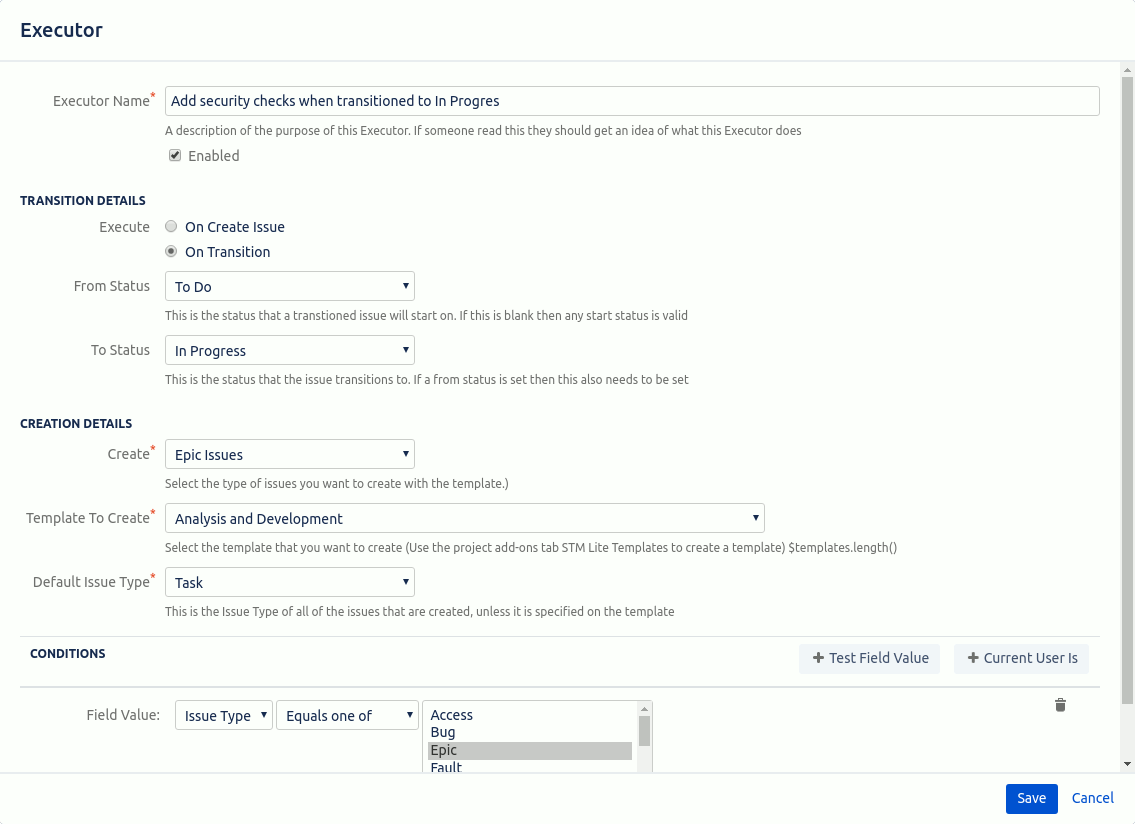
At the top of the dialog is the name of the Executor. This should descriptive enough to understand what it does. Under this is the enabled checkbox which allows you to start/stop an Executor from running.
In the Transition Details section allows you to specify if the Executor will be executed when an Issue is created or transitioned. If you select "On Transition" then you need to specify which transition you are interested in. You must select a To Status and optionally a From Status. The list of statuses you can select from are the statuses from all projects (Atlassian don't give us the ability to differentiate which one belong to which projects).
For the above example, the Executor will only work when you are transitioning from the To Do status to the In Progress status. If you left the From Status blank then a transition from any status to In Progress would executor this Executioner.
The Creation details allow you to specify which type of issues you want to create (Sub Tasks, Epic or Linked), the template you want to use to create issues and the default issue type. The default issue type is used as the issue type for the new issues only when they are not specified in the template.
The conditions allow you to optionally specify conditions that will allow this Executor to run. With the Lite version of Sub Task Manager you can only specify the Issue Type(s) and who the current user is.
Automatic Issue Creation In Action (Executors)
When an Issue completes a transition or is created then any relevant Executor are run to automatically creates sub task(s) / linked issue(s) / Epic issue(s). For transition Executors you will be shown pending and created message boxes to inform the user that processing has occurring in the background. When the Issues are created then the Issue is refreshed to display the new Issues and a message is displayed to show that they have been created. Below are examples of the pending and created messages
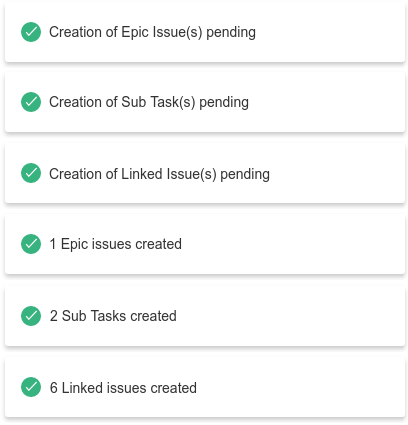
If an error occurs during the creation process then an error message will be displayed telling the user what happened.

As well as being displayed in the popup dialog all STM Lite Workflow Errors are also available in a project administration (see below). All attempts at running Executors will also be displayed in the STM Lite Audit page showing whether the Executor ran correctly or not.
Permissions Error: If you get errors saying that the user does not have permission to view or edit an Epic then you will need to give edit and viewing permission of the plugins user (Sub Task Manager Lite).
Executor Errors
Any errors that occur during the creation of Sub Tasks, Linked Issues or Epic Issues from an Executor can be viewed under the "STM Lite Errors" tab in a project administration screen. Details are kept for up to two weeks after the error occurs (at which time they are deleted).

Executor Audit
Every time an Executor is run then a record can be viewed in the Project Admin -> STM Lite Audit tab. This shows you whether it ran successfully, if the conditions were met, how many issues were created...
